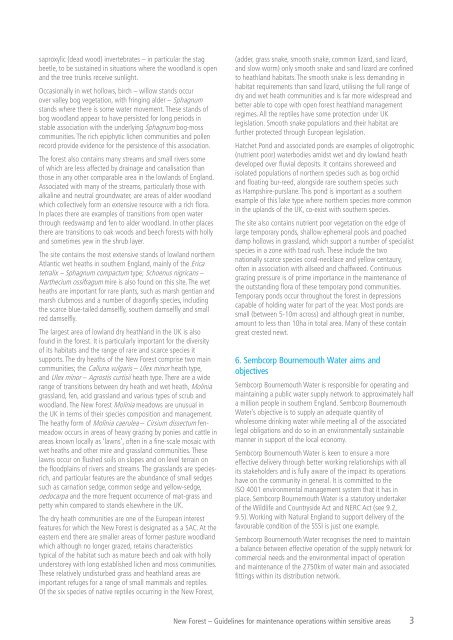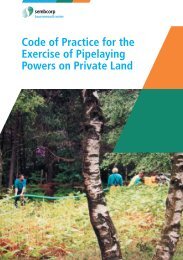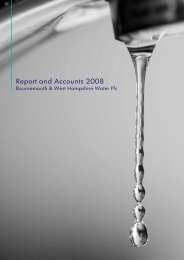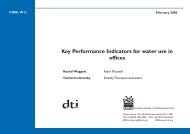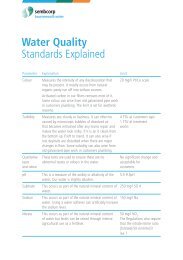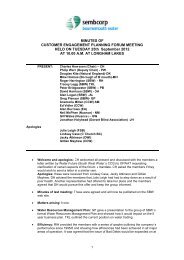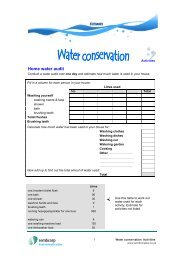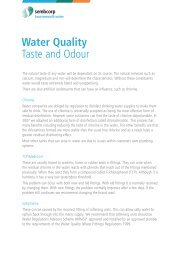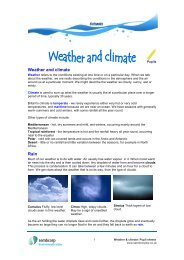New Forest - Sembcorp Bournemouth Water
New Forest - Sembcorp Bournemouth Water
New Forest - Sembcorp Bournemouth Water
- No tags were found...
You also want an ePaper? Increase the reach of your titles
YUMPU automatically turns print PDFs into web optimized ePapers that Google loves.
saproxylic (dead wood) invertebrates – in particular the stagbeetle, to be sustained in situations where the woodland is openand the tree trunks receive sunlight.Occasionally in wet hollows, birch – willow stands occurover valley bog vegetation, with fringing alder – Sphagnumstands where there is some water movement. These stands ofbog woodland appear to have persisted for long periods instable association with the underlying Sphagnum bog-mosscommunities. The rich epiphytic lichen communities and pollenrecord provide evidence for the persistence of this association.The forest also contains many streams and small rivers someof which are less affected by drainage and canalisation thanthose in any other comparable area in the lowlands of England.Associated with many of the streams, particularly those withalkaline and neutral groundwater, are areas of alder woodlandwhich collectively form an extensive resource with a rich flora.In places there are examples of transitions from open waterthrough reedswamp and fen to alder woodland. In other placesthere are transitions to oak woods and beech forests with hollyand sometimes yew in the shrub layer.The site contains the most extensive stands of lowland northernAtlantic wet heaths in southern England, mainly of the Ericatetralix – Sphagnum compactum type; Schoenus nigricans –Narthecium ossifragum mire is also found on this site. The wetheaths are important for rare plants, such as marsh gentian andmarsh clubmoss and a number of dragonfly species, includingthe scarce blue-tailed damselfly, southern damselfly and smallred damselfly.The largest area of lowland dry heathland in the UK is alsofound in the forest. It is particularly important for the diversityof its habitats and the range of rare and scarce species itsupports. The dry heaths of the <strong>New</strong> <strong>Forest</strong> comprise two maincommunities; the Calluna vulgaris – Ulex minor heath type,and Ulex minor – Agrostis curtisii heath type. There are a widerange of transitions between dry heath and wet heath, Moliniagrassland, fen, acid grassland and various types of scrub andwoodland. The <strong>New</strong> <strong>Forest</strong> Molinia meadows are unusual inthe UK in terms of their species composition and management.The heathy form of Molinia caerulea – Cirsium dissectum fenmeadowoccurs in areas of heavy grazing by ponies and cattle inareas known locally as ‘lawns’, often in a fine-scale mosaic withwet heaths and other mire and grassland communities. Theselawns occur on flushed soils on slopes and on level terrain onthe floodplains of rivers and streams. The grasslands are speciesrich,and particular features are the abundance of small sedgessuch as carnation sedge, common sedge and yellow-sedge,oedocarpa and the more frequent occurrence of mat-grass andpetty whin compared to stands elsewhere in the UK.The dry heath communities are one of the European interestfeatures for which the <strong>New</strong> <strong>Forest</strong> is designated as a SAC. At theeastern end there are smaller areas of former pasture woodlandwhich although no longer grazed, retains characteristicstypical of the habitat such as mature beech and oak with hollyunderstorey with long established lichen and moss communities.These relatively undisturbed grass and heathland areas areimportant refuges for a range of small mammals and reptiles.Of the six species of native reptiles occurring in the <strong>New</strong> <strong>Forest</strong>,(adder, grass snake, smooth snake, common lizard, sand lizard,and slow worm) only smooth snake and sand lizard are confinedto heathland habitats. The smooth snake is less demanding inhabitat requirements than sand lizard, utilising the full range ofdry and wet heath communities and is far more widespread andbetter able to cope with open forest heathland managementregimes. All the reptiles have some protection under UKlegislation. Smooth snake populations and their habitat arefurther protected through European legislation.Hatchet Pond and associated ponds are examples of oligotrophic(nutrient poor) waterbodies amidst wet and dry lowland heathdeveloped over fluvial deposits. It contains shoreweed andisolated populations of northern species such as bog orchidand floating bur-reed, alongside rare southern species suchas Hampshire-purslane. This pond is important as a southernexample of this lake type where northern species more commonin the uplands of the UK, co-exist with southern species.The site also contains nutrient poor vegetation on the edge oflarge temporary ponds, shallow ephemeral pools and poacheddamp hollows in grassland, which support a number of specialistspecies in a zone with toad rush. These include the twonationally scarce species coral-necklace and yellow centaury,often in association with allseed and chaffweed. Continuousgrazing pressure is of prime importance in the maintenance ofthe outstanding flora of these temporary pond communities.Temporary ponds occur throughout the forest in depressionscapable of holding water for part of the year. Most ponds aresmall (between 5-10m across) and although great in number,amount to less than 10ha in total area. Many of these containgreat crested newt.6. <strong>Sembcorp</strong> <strong>Bournemouth</strong> <strong>Water</strong> aims andobjectives<strong>Sembcorp</strong> <strong>Bournemouth</strong> <strong>Water</strong> is responsible for operating andmaintaining a public water supply network to approximately halfa million people in southern England. <strong>Sembcorp</strong> <strong>Bournemouth</strong><strong>Water</strong>’s objective is to supply an adequate quantity ofwholesome drinking water while meeting all of the associatedlegal obligations and do so in an environmentally sustainablemanner in support of the local economy.<strong>Sembcorp</strong> <strong>Bournemouth</strong> <strong>Water</strong> is keen to ensure a moreeffective delivery through better working relationships with allits stakeholders and is fully aware of the impact its operationshave on the community in general. It is committed to theISO 4001 environmental management system that it has inplace. <strong>Sembcorp</strong> <strong>Bournemouth</strong> <strong>Water</strong> is a statutory undertakerof the Wildlife and Countryside Act and NERC Act (see 9.2,9.5). Working with Natural England to support delivery of thefavourable condition of the SSSI is just one example.<strong>Sembcorp</strong> <strong>Bournemouth</strong> <strong>Water</strong> recognises the need to maintaina balance between effective operation of the supply network forcommercial needs and the environmental impact of operationand maintenance of the 2750km of water main and associatedfittings within its distribution network.<strong>New</strong> <strong>Forest</strong> – Guidelines for maintenance operations within sensitive areas 3


